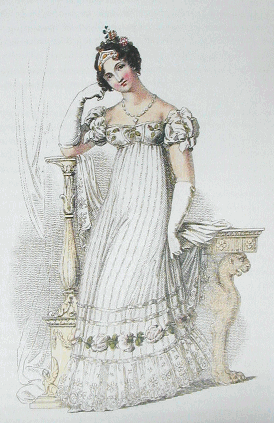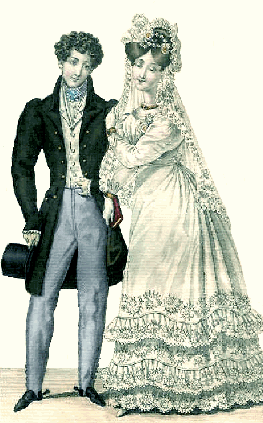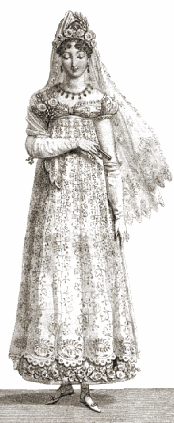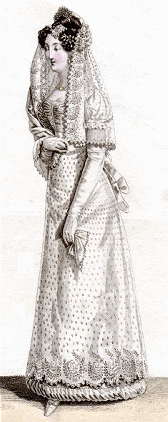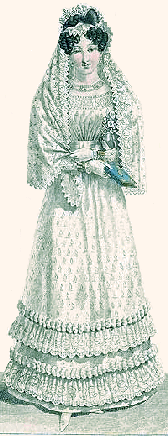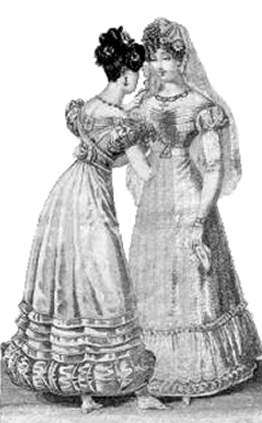Illustration:
11. 'Bridal dress' Ackermann's Repository of Arts, Literature, Commerce, Manufactures, Fashion and Politics, June 1816.
12. Bridal couple, plate #15, Le Journal des Dames et Des Modes (Costumes Parisien) 1826
13. 'Une Mariee' (A bride) Journal des Dames 10 September 1813
14. Journal des Dames 1820, plate #1913
15. Journal des Dames 1823
16. 'Mariee et de Demoinselle d'Honneur' (The bride and the maid of honor) Journal des Dames 1824
Notes on the text:
o: Properly "Ackermann's Repository of Arts, Literature, Commerce, Manufactures, Fashion and Politics," published 1809-1829 by Rudolph Ackermann. Ackermann was a German carriage designer by trade when he moved to London 1783. By 1800 he was the leading publisher of the Regency era, publishing well over 300 books, plus innumerable prints and periodicals over his career. Ackermann was more than just a printer. A major patron of the Arts, he ran a drawing school, employed his own artists (Thomas Rowlandson worked constantly for him over three decades) and also manufactured art supplies such as watercolor paints. He shop was technologically advanced, 1811 he had gas light installed at the premises at 101, The Strand. The quality of his prints were second to none, using the Alois Senefelder's process of lithography which he patented in England 1817.
p: Plate 33, 'Bridal Dress' from No 6, Volume 1, Ackermann's Repository, June 1816: "A frock of striped French gauze over a white satin slip; the bottom of the frock is superbly trimmed with a deep flounce of Brussels lace, which is surmounted by a single tuck of byas white satin, and a wreath of roses; above the roses are two tucks of byas white satin. We refer our readers to our print for the form of the body and sleeve: it is singularly novel and tasteful, but we are forbidden either to describe it, or to mention the materials of which it is composed. The hair is dressed low at the sides, and parted so as to entirely display the forehead: it is ornamented with an elegant aigrette of pearls in front, and a sprig of French roses placed nearly at the back of the head. Necklace, earrings and breacelets of pearl. White kid gloves, and white satin slippers.
We have to thank Mrs. Gill, of Cork-street, Burlington Gardens, for both our dresses this month; and we must observe, that the one we have just described, is a wedding-dress which she has recently finished for a young lady of high distinction."
q: Bridal couple, plate #15, Le Journal des Dames et Des Modes (Costumes Parisien) 1826
Fig. 1 (Bride) Wedding costume. Hairstyle executed by Monsieur Croizat forming a kind of enclosed bonnet to which is fitted the veil of blonde lace. Dress of blonde lace, white shoes & white gloves.
Fig. 2 (Groom) Beaver hat, fine striped cravat. Double waistcoat of pique (a patterned white fabric). Double-breasted coat with velvet collar and round gold buttons. Cashmere trousers fasten in front and button on lower part.
Text translated from the original French plate, description courtesy of Brenda Sneathen Mattox of Fancy Ephemera Paper Dolls
r: Costume Parisien par Le Journal des Dames et Des Modes, published June 1, 1797 - January 5, 1839. The magazine was small, containing, besides the cover, only eight pages of text and one engraving. The engravings were colorized by hand. Not to be confused with the earlier 'Le Journal des Dames', published 1759–78 and considered the first true women's magazine devoted to health, education and fashion.
s: Journal des Dames 1820, plate #1913 Title: "Coiffure de Mariée, ornie d'un croissant de fleurs d'oranger, d'une branche de tubireuse et d'un voile d'Angleterre. Cette Coiffure composée et exicutie par Mme Plaisir. Robe de dentelle, dessous de satin. (Bridal hairstyle decorated with a crescent of orange blossom, a sprig of tuberose and an English veil. Hairstyle designed and executed by M. Plaiser. Lace over satin dress.)"
Text translated from the original French plate, description courtesy of Brenda Sneathen Mattox of Fancy Ephemera Paper Dolls
t: Journal des Dames 1823
u: Journal des Dames 1824 Title: "Costume de mariée et demoiselle d'honneur. Les robes de la facon de Mme Hyppolite" (Clothes for the bride and maid of honor. Dress fashions from Mme Hyppolite) |
